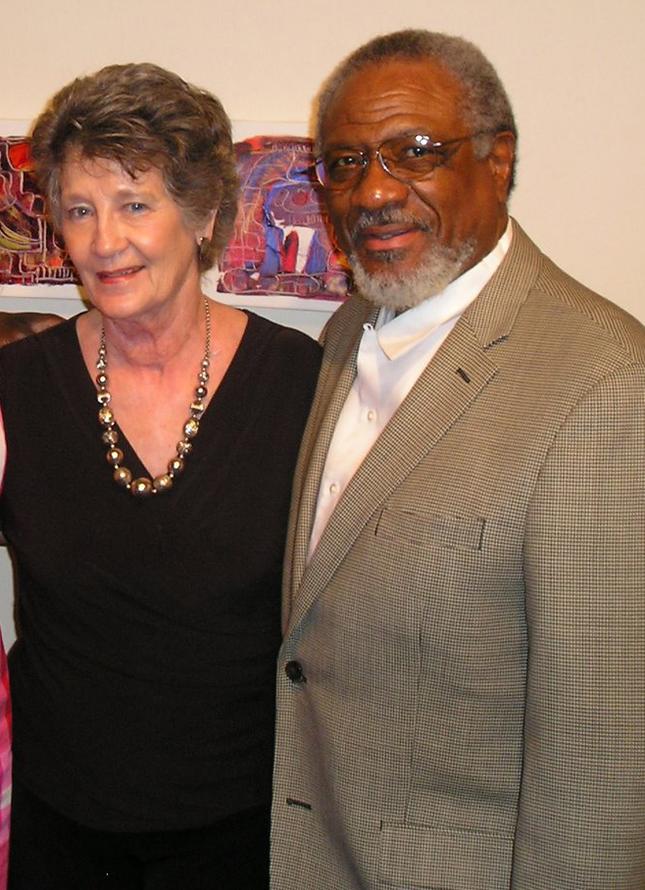The Parish Gallery, 22 Years Strong
By • June 20, 2013 0 1722

Occasionally, an art gallery comes along that helps define a neighborhood’s culture. When Norman Parish saw a “Gallery Space for Rent” sign in Georgetown’s Canal Square one Saturday afternoon in 1990, he did not know that gallery was going to be his.
He and his now wife Gwen, who runs the Parish Gallery with him today, were visiting One Step Down, the legendary local jazz club on Pennsylvania Avenue (now closed). It was their frequent haunt since Norman had moved to Washington in 1988 for work at an engineering firm.
He had always been an artist—in Chicago, he worked alongside many of the founding members of the AfriCOBRA art movement, including Jeff Donaldson and Wadsworth Jarrell. He helped paint The Wall of Respect in 1967, an outdoor mural on the South Side of Chicago by a group of artists from the Organization of Black American Culture. The Pulitzer Prize-winning poet Gwendolyn Brooks even wrote a poem about it, titled “The Wall.”
Norman long had aspirations to open a gallery, and when he saw this opportunity, he took it. The Parish Gallery opened its doors in June of 1991, marking the beginning of hundreds of exhibitions and artists the Gallery would host over the years.
In the beginning, Norman did not sleep. “He would get up at 3 a.m., get off at 3 p.m., and come to the gallery for the rest of the night to open the doors for Georgetown’s evening.
“It’s because I found out how many artists there were that needed support,” says Norman. “They were good, really good. But they needed someone to help get their work out into the world.”
“At first, a lot of the artists we featured I knew from art school,” he says. “But around 93 and 94, other artists just started coming to me. These were artists missing opportunities because nobody was looking out for them, nobody was out there promoting their work.”
It was also important for him to continue his work in Chicago, promoting the work of artists from the African diaspora alongside artists from other walks of life.
“It was his passion,” says Gwen. “He was an artist, and he understood the difficulties artists encounter in trying to get their work out.”
“Norman never used his gallery as a showcase for his own work,” says Alla Rogers, a friend, neighbor, and owner of Alla Rogers Gallery. “His business was dedicated to focusing on underappreciated groups of artists.”
Over the years, The Parish Gallery has exhibited works by artists from Nigeria, Ethiopia, Ghana, South Africa and Morocco, alongside those from Greece, Turkey, Brazil, Spain and France. He forges Eastern, Western and African traditions with a harmony and ease of diversity that most gallerists work their entire lives achieve.
He has had success with his own artwork as well—he was selected as part of a traveling exhibition with the Smithsonian, “Seeing Jazz,” in the late 1990s.
In May of last year, a malignant tumor was discovered in Norman’s brain, and he underwent surgery immediately to have it removed. It has been a slow road to recovery in the following months, but as he points out, “I’ve been having more good days than bad days, and things are looking up again.”
After taking it easy for the second half of a year, the Gallery’s current exhibit is a “welcome back” of sorts. The current group show, “Through the Years,” features over 50 gallery artists that show Norman’s ability and range as a curator. It encapsulates the effect he has had on the Georgetown community and the people he and Gwen have brought together since the Gallery’s founding.
“And there’s more to come,” he says. “This isn’t even half. I have more artists than I can actually show, and I plan on hosting a follow-up exhibit in the near future.”
Norman is a true American artist, and The Parish Gallery represents the great artistic breadth that Washington has to offer. And we have confidence that he and Gwen will continue their artistic mission for many years to come.

